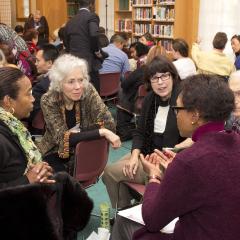Riane Eisler: the Partnership Model of Human Organization
Riane Eisler is a cultural historian, systems theorist, and the author of many books, including The Chalice and the Blade: Our History, Our Future. She is president of the Center for Partnership Studies and frequently consults on the application of the partnership model and cultural transformation theory to all aspects of life. “Caring,” she maintains, “is the key to partnership – not only on the individual level, but also on the level of social and economic rules and practices.” She provided a keynote address for the Center’s seminar, “Economics for Human Well-Being: Advancing a People’s Agenda,” in March 2001. Karen Nardella interviewed Dr. Eisler before the event.
We are concerned about globalization. How would you assess the impact of the current policies of the WTO, IMF, and World Bank on developing nations?
These policies have been set up to generate a profit for the dominant economies. But what they also do is create alliances among people within the developing world who control a lot of resources. It’s important to acknowledge that what it comes down to is the impoverishment of masses of people and, at the same time, the enrichment of those who are in control. We’re talking about the structuring of economic relations, social relations, human relations, and political relations in terms of rankings of superiors over inferiors.
To be honest about this, these policies don’t really benefit nations as nations. They benefit the elite in those nations. We have to look at the entire economic system and the assumptions about current economic rules. These policies are guided by the wrong economic assumptions — very antiquated economic rules which only value exchange as an economic transaction.
Because of these international economic policies, cutbacks in social services have been required in developing countries as part of the tightening of the purse strings. Well, this is thinking only of economic consequences and not of the human beings involved. And it’s not even economically efficient. The economic problems that this kind of thinking creates are horrendous. For example, if you cut social services, you don’t have health services for people; therefore, one of the consequences is that you get much less efficient workers.
But there’s much more. The assumption is that somebody is going to pick up those services and that somebody, of course, is women. If you look at the study that I did with social psychologist David Loye and sociologist Kari Norgaard called “Women, Men and the Global Quality of Life,” you’ll see the analysis of what really happens. It is women who start to do much more in order to maintain some semblance of health for their children and their families. They drop out of school to get jobs. They will sacrifice themselves, as they’ve been socialized to do, so that a child has something to eat. In other words it’s a shifting of the burden to those who are not visible in the economic system.
Would you comment on the influence multinational corporations are exercising in the world?
There is no question but that we have moved into a system where, to a very large extent, multinational corporations really own governments. In what I call “dominator communism” in the Soviet Union, there was really a state capitalism where the government owned the corporations. What we’re seeing now in the so-called capitalist world is a system where the corporations, de facto, own the governments. But it’s all part of the same dominator system.
We are always trying to put Band-Aids on the system. There is absolutely no way that we’re going to get these corporations to change their ways unless the economic system is restructured. This is not different from what was going on in the Robber Baron Era of late 19th and early 20th century capitalism; it’s just that it has become globalized and more visible.
How would your partnership model address this structural problem?
My partnership model of social organization offers a viable alternative to the complex tensions inherent in relations based on domination and subordination. But change doesn’t take place in a linear way. If you look at the last 300 years of modern history through the analytical lens of the partnership-dominator continuum, we have made enormous gains but they have always been made against enormous resistance and punctuated by periods of regression.
We’ve had one social movement after another challenging entrenched traditions of domination. We’ve struggled against the divine right of kings to rule over their subjects; the divine right of men to rule over women and children in the “castles of their homes;” the right of one race to rule over another. So we have seen progress. Progress comes in bursts and then there are periods of regression and we have to fight again because we still haven’t changed the foundations of the system. It is precisely because we are in a new period of regression that it is so very important that we have a proactive rather than only a reactive agenda.
What is the proactive agenda you would recommend?
There are certain foundations we have to build. This is really the lesson of the last 300 years. It is not coincidental that the most brutal “dominator” regressions have occurred in places where a very authoritarian, male-dominated family was still in place. Nor is it coincidental that when Hitler came into power, one of the first rallying cries was: let’s get women back into their place in a traditional family. When Khomeini came into power, that was again the rallying cry.
Our intimate relations are foundational because that’s where we first learn models for relationships
Riane Eisler
My work in The Chalice and the Blade looks at commonalties between regimes or times that orient more to the partnership than the dominator model and vice versa. Again and again, what I see is that our intimate relations — parent-child relations, woman-man relations — are foundational because that’s where we first learn models for relationships. That’s why the proactive agenda I advocate begins with childhood relations and gender relations and builds from there to economic and spiritual relations. These are the four cornerstones.
It’s not coincidental that in those countries that have moved more toward the partnership model — the Scandinavian nations — there are laws on the books making it illegal for parents to hit children. It’s also not coincidental that those are the countries that have come the farthest in gender equity. They’re not perfect, but nothing ever is going to be perfect.
Are there changes women need to make in their own lives in order to promote a partnership model?
How women need to change and how they can change really are two different questions. In many nations of the developing world, women will only be able to change when the laws and customs that prohibit them from owning land are changed. Land is still the basis for power. They must have equal access to education. Also, education has to change because most education is still by, for, and about men.
It isn’t enough to give women access to the economic system as it is because, given the fact that men are not involved in taking care of children in many of these traditional cultures, this puts another burden on women: external work plus caretaking. They then really have two full-time jobs. So we’re talking about changing the economics, changing education, and also changing family planning. To talk about freedom to a woman who has no reproductive freedom is the most ridiculous thing in the world. If she doesn’t have freedom to even decide what happens to her own body — whether she gets pregnant or not, whether she has to have another child because she hasn’t had a son yet — what is the point of talking of freedom to this woman?
What do men have to gain from the partnership model of social organization?
What men have to gain is a much more humane way of living. Shifting from domination to partnership is not a matter of women against men. It is a matter of benefiting both halves of humanity. As the status of women rises, so does the status of those values stereotypically associated with femininity such as creativity, sensitivity, and nurturing. This offers men the opportunity to live fuller lives and express more aspects of their character. Another way that men’s lives might be improved is by being safer. The male socialization process that we live with now pushes them into violent activities, from war to combative sports. In the poorest areas, you see most vividly what the dominator model will do. You see the nutritional preference for boys. If there isn’t enough food, for example, the mother feeds the boy. The girl becomes malnourished. Now, suppose the girl child survives. She is going to produce children who are below par because her health has been compromised by an unhealthy socialization process. Some of her children will be boys. The cycle is self-perpetuating.
How should we go about re-educating people for a more balanced society?
When you have a system where the model for adult relations is one where one type of person is supposed to serve and the other type of person is to be served, what you have then is a model for economic inequity. We need education for children and parents that is gender balanced but that also helps young people to see these connections and how they relate to their own lives. I am currently developing curricula for children of all ages with these goals in mind.
How else are you going to really give young people the opportunity to see that there’s another possibility? They have to participate in partnership structures and the content has to be different. There have to be alternative narratives that form our mental maps. This is what I am proposing in my new book Tomorrow’s Children.
Others who advocate for the economic empowerment of women focus on gainful employment outside the home. You, on the other hand, call for social policies that reward caring and caretaking work. Why this different approach?
When I was involved in the Women’s Movement, starting in the late 1960s, the want ads in this country used to be segregated into two categories, Help Wanted: Male and Help Wanted: Female. All the good jobs were for men and all the dead-end jobs for women. We got those categories eliminated. We were really focusing on the empowerment of women as they entered the market economy. But I’ve realized that while this is important, it is not enough.
The first thing I suggest — and I’m not the only one — is that we have to include all the work done by women in calculations of economic productivity. If you don’t measure it, it doesn’t exist, and then policies are guided by a totally false system of accounting. If, for example, a business were to leave certain segments of a factory’s labor force out of its financial statements, the balance sheet would not be accurate, would it?
Marx wrote about the alienation of labor and I write about the alienation of caring labor. What we really need are economic inventions. I am not saying that women shouldn’t have entry into and high reward from good professions, but that’s not enough. What we need is a more caring economic system, an economics of caring, and you’re never going to have that unless caring work is given higher value both in the formal economy and in the informal economy.
Every single economic institution and rule is a human invention. It can be a dominator economic invention such as slavery or a partnership economic invention like social security. Social security, however, doesn’t include women who stay in the house and take care of their children. They only get derivative benefits so they receive less. Can you explain to me why an older woman would need less than an older man? It is because she is devalued: because her work does not count. Yet we wouldn’t have a work force if it weren’t for that work. Paid parental leave is an economic invention that actually gives visibility and an economic reward for caring and caregiving. We need to give training and tremendous resources for caregiving. Then, that work becomes more visible and more prestigious.
The Scandinavian nations are way ahead of us. Finland was the first country where women got the vote. There was a very well organized women’s movement, which was respected. The Scandinavian countries are far more partnership oriented. You don’t have numerous homeless people. You don’t have extreme poverty. The very rich don’t have monumental houses and palaces.
In the end, the whole point is that we need economic inventions, including corporate charters that incorporate the notion of caring — caring for other people and caring for our natural environment. But it’s not going to happen without a change of cultural values and beliefs.


